12 Prehistory
The Paleolithic Period
Paleolithic Architecture
The oldest examples of Paleolithic dwellings are shelters in caves, followed by houses of wood, straw, and rock.
Key Points
- Early humans chose locations that could be defended against predators and rivals and that were shielded from inclement weather.
- Weather, water, and time have destroyed the majority of campsites; our understanding of Paleolithic dwellings is therefore limited.
- Caves are the most famous example of Paleolithic shelters.
Key Terms
- Mammoth: A large, hairy, extinct elephant-like mammal of the taxonomic genus Mammuthus.
- Hut: A small wooden shed, a primitive temporary dwelling.
- Paleolithic: Paleo (Old) Lith (Stone); Early stage of the Stone Age, when primitive stone tools were used.
The Paleolithic Age, or Old Stone Age, spanned from around 30,000 BCE until 10,000 BCE and produced the first accomplishments in human creativity. Due to a lack of written records from this time period (Pre-history), nearly all of our knowledge of Paleolithic human culture and way of life comes from archaeologic and ethnographic comparisons to modern hunter-gatherer cultures. The Paleolithic lasted until the retreat of the ice, when farming and use of metals were adopted.
Paleolithic Societies
A typical Paleolithic society followed a hunter-gatherer economy. Humans hunted wild animals for meat and gathered food, firewood, and materials for their tools, clothes, or shelters. The adoption of both technologies—clothing and shelter—cannot be dated exactly, but they were key to humanity’s progress. As the Paleolithic era progressed, dwellings became more sophisticated, more elaborate, and more house-like. At the end of the Paleolithic era, humans began to produce works of art such as cave paintings, rock art, and jewelry, and began to engage in religious behavior such as burial and rituals.
Dwellings and Shelters
Early men chose locations that could be defended against predators and rivals and that were shielded from inclement weather. Many such locations could be found near rivers, lakes, and streams, perhaps with low hilltops nearby that could serve as refuges. Since water can erode and change landscapes quite drastically, many of these campsites have been destroyed. Our understanding of Paleolithic dwellings is therefore limited.
As early as 380,000 BCE, humans were constructing temporary wood huts . Other types of houses existed; these were more frequently campsites in caves or in the open air with little in the way of formal structure. The oldest examples are shelters within caves, followed by houses of wood, straw, and rock. A few examples exist of houses built out of bones.

Caves
Caves are the most famous example of Paleolithic shelters, though the number of caves used by Paleolithic people is drastically small relative to the number of hominids thought to have lived on Earth at the time. Most hominids probably never entered a cave, much less lived in one. Nonetheless, the remains of hominid settlements show interesting patterns. In one cave, a tribe of Neanderthals kept a hearth fire burning for a thousand years, leaving behind an accumulation of coals and ash. In another cave, post holes in the dirt floor reveal that the residents built some sort of shelter or enclosure with a roof to protect themselves from water dripping on them from the cave ceiling. They often used the rear portions of the cave as middens, depositing their garbage there.
In the Upper Paleolithic (the latest part of the Paleolithic), caves ceased to act as houses. Instead, they likely became places for early people to gather for ritual and religious purposes.
Tents and Huts
Modern archaeologists know of few types of shelter used by ancient peoples other than caves. Some examples do exist, but they are quite rare. In Siberia, a group of Russian scientists uncovered a house or tent with a frame constructed of mammoth bones. The great tusks supported the roof, while the skulls and thighbones formed the walls of the tent. Several families could live inside, where three small hearths, little more than rings of stones, kept people warm during the winter. Around 50,000 years ago, a group of Paleolithic humans camped on a lakeshore in southern France. At Terra Amata, these hunter-gatherers built a long and narrow house. The foundation was a ring of stones, with a flat threshold stone for a door at either end. Vertical posts down the middle of the house supported roofs and walls of sticks and twigs, probably covered over with a layer of straw. A hearth outside served as the kitchen, while a smaller hearth inside kept people warm. Their residents could easily abandon both dwellings. This is why they are not considered true houses, which was a development of the Neolithic period rather than the Paleolithic period.
Paleolithic Artifacts
The Paleolithic era has a number of artifacts that range from stone, bone, and wood tools to stone sculptures.
Key Points
- Artifacts dating from the Lower and Middle Paleolithic remain disputed as objects of artistic expression.
- There is some evidence that a preference for aesthetic emerged in the Middle Paleolithic due to the symmetry inherent to discovered artifacts.
- The (So-called) Venus of Tan-Tan is an alleged artifact found in Morocco that is believed by some archaeologists to be the earliest representation of the human form.
- The Paleolithic is characterized by the use of stone tools, although at the time humans also used wood and bone tools.
Key Terms
- ochre: An earth pigment containing silica, aluminum, and ferric oxide.
- incised: To cut into the surface of an object for decorative purposes.
- flint: A hard, fine-grained quartz that fractures conchoidally and generates sparks when struck.
- paleoliths: A stone relic of the Paleolithic era.
- artifacts: Objects that are created by a human being with cultural and historical significance.
The Paleolithic or Old Stone Age originated around 30,000 BCE, lasting until 10,000 BCE, and is separated into three periods: the Lower Paleolithic (the earliest subdivision), Middle Paleolithic, and Upper Paleolithic. The Paleolithic era is characterized by the use of stone tools, although at the time humans also used wood and bone tools. Other organic commodities were adapted for use as tools, including leather and vegetable fibers; however, due to their nature, these have not been preserved to any great degree. Surviving artifacts of the Paleolithic era are known as paleoliths.

The earliest undisputed art originated in the Upper Paleolithic. However, there is some evidence that a preference for aesthetic emerged in the Middle Paleolithic due to the symmetry inherent in discovered artifacts and evidence of attention to detail in such things as tool shape, which has led some archaeologists to interpret these artifacts as early examples of artistic expression. There has been much dispute among scholars over the terming of early prehistoric artifacts as “art.” Generally speaking, artifacts dating from the Lower and Middle Paleolithic remain disputed as objects of artistic expression, while the Upper Paleolithic provides the first conclusive examples of art making.
Disputed Art(ifacts): Early “Venuses”
The “Venus” of Tan-Tan is an alleged artifact found in Morocco that is believed by some to be the earliest representation of the human form . The name “Venus” is no longer considered appropriate because it suggests that these objects were representative of goddesses, or other deities, when there is no proof that this is so. The term is still in use but here we will demote these figures to the designation “Woman” which is usually undeniable by the physical gendered characteristics, although the Tan-Tan figure is arguably not gendered. The Woman of Tan-Tan, a 2.3 inch long piece of quartzite rock dated between 300,000 and 500,000 years ago during the Middle Paleolithic, was discovered in 1999 in a river terrace deposit on the north bank of the Draa River, just south of the Moroccan village of Tan-Tan. There is controversy among archaeologists as to its nature and origin. Some archaeologists believe it was created by a combination of geological forces as well as tool-based carving. Visible smudge stains have been interpreted by some as remnants of red ochre pigments. For others, the rock’s shape is simply the result of natural weathering and erosion, and any human shape is a mere coincidence.
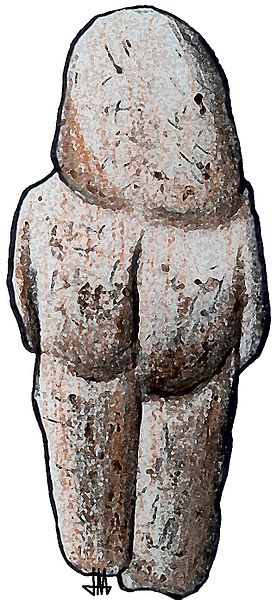
Blombos Cave
Discoveries of engraved stones in the Blombos Caves of South Africa has led some archaeologists to believe that early Homo sapiens were capable of abstraction and the production of symbolic art. Made from ochre, the stones are engraved with abstract patterns, and while they are simpler than prehistoric cave paintings found in Europe, some scholars believe these engraved stones represent the earliest known artworks, dating from 75,000 years ago. Although, much like the other pieces, this belief remains contested.

Paleolithic Cave Paintings
Paleolithic cave paintings demonstrate early humans’ capacity to give meaning to their surroundings and communicate with others.
Key Points
- Cave paintings can be grouped into three main categories: animals, human figures, and abstract signs.
- Animals depicted include familiar herbivores and predatory animals.
- Animals were shown in profile
- The most spectacular examples of cave paintings are in southern France and northern Spain.
- Interpretations vary from prehistoric star charts, accounts of past hunts or mystical rituals for future ones, and shamanism.
Key Terms
- chiaroscuro: An artistic technique developed during the Renaissance, referring to the use of exaggerated light contrasts in order to create the illusion of volume.
- shamanism: A range of traditional beliefs and practices concerned with communication with the spirit world.
- polychromy: Refers to the use of multiple colors in an object or artwork.
- schematic: following a set form, often geometric, and repeatable.
The Paleolithic, or Old Stone Age, ranges from 30,000 BCE to 10,000 BCE and produced the first accomplishments in human creativity, preceding the invention of writing. Archaeological discoveries across a broad swath of Europe (especially southern France and northern Spain) include over two hundred caves with spectacular paintings, drawings, and sculpture that are among the earliest undisputed examples of representational image-making.
Themes and Materials
The most common themes in cave paintings are large wild animals, such as bison, horses, aurochs (a kind of bull), and deer. The species found most often were suitable for hunting by humans, but were not necessarily the typical prey found in associated bone deposits. For example, the painters of Lascaux, France left mainly reindeer bones, but this species does not appear at all in the cave paintings; equine species are the most common.
Drawings of humans were rare and were usually schematic in nature as opposed to the detailed and naturalistic images of animals. Tracings of human hands and hand stencils were very popular, however, as well as abstract patterns called finger flutings. Animals were pictured in profile to give the most identifiable information about each one as possible.
The pigments used appear to be red and yellow ochre, manganese or carbon for black, and china clay for white. Some of the color may have been mixed with fat. The paint was applied by finger, chewed sticks, or using fur for brushes. Sometimes the silhouette of the animal was incised in the rock first, and in some caves many of the images were only engraved in this fashion, taking them out of a strict definition of “cave painting.”
Main Examples of Cave Paintings: France and Spain
France
Lascaux (circa 15,000 BCE), in southwestern France, is an interconnected series of caves with one of the most impressive examples of artistic creations by Paleolithic humans.

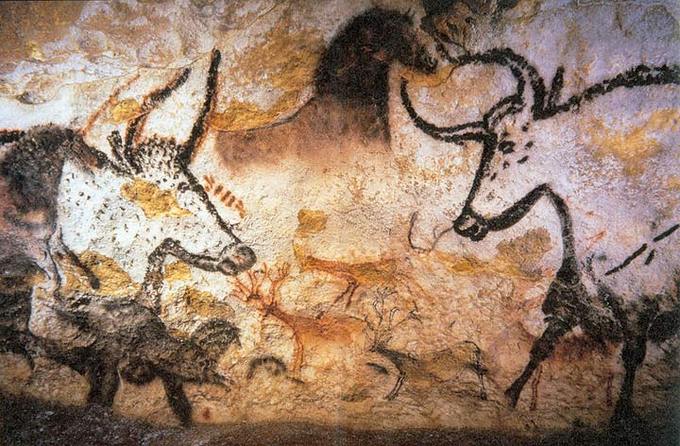
Discovered in 1940, the cave contains nearly two thousand figures, which can be grouped into three main categories—animals, human figures, and abstract signs. Over nine hundred images depict animals from the surrounding areas, such as horses, stags, aurochs, bison, lions, bears, and birds—species that would have been hunted and eaten, and those identified as predators. The paintings contain no images of the surrounding landscape or the vegetation of the time.
The Chauvet-Pont-d’Arc Cave (circa 30,000 BCE) in the Ardèche department of southern France contains some of the earliest known paintings, as well as other evidence of Upper Paleolithic life. The Chauvet Cave is uncharacteristically large, and the quality, quantity, and condition of the artwork found on its walls have been called spectacular. Hundreds of animal paintings have been catalogued, depicting at least thirteen different species—not only the familiar herbivores that predominate Paleolithic cave art, but also many predatory animals, such as cave lions, panthers, bears, and cave hyenas.
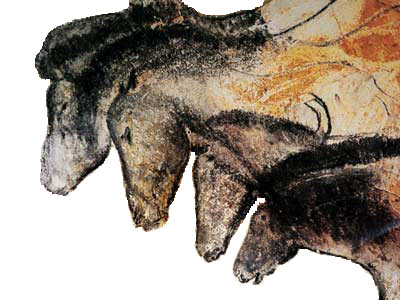
As is typical of most cave art, there are no paintings of complete human figures in Chauvet. There are a few panels of red ochre hand prints and hand stencils made by spitting pigment over hands pressed against the cave surface. Abstract markings—lines and dots—are found throughout the cave.
The artists who produced these unique paintings used techniques rarely found in other cave art. Many of the paintings appear to have been made after the walls were scraped clear of debris and concretions, leaving a smoother and noticeably lighter area upon which the artists worked. Similarly, a three-dimensional quality and the suggestion of movement are achieved by incising or etching around the outlines of certain figures. The art also includes scenes that were complex for its time—animals interacting with each other. For instance, a pair of wooly rhinoceroses are seen butting horns in an apparent contest for territory or mating rights.
Spain
Altamira (circa 18,000 BCE) is a cave in northern Spain famous for its Upper Paleolithic cave paintings featuring drawings and polychrome rock paintings of wild mammals and human hands. The cave has been declared a World Heritage Site by UNESCO.
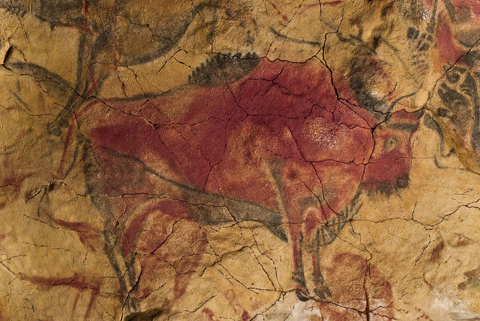
The long cave consists of a series of twisting passages and chambers. Human occupation was limited to the cave mouth, although paintings were created throughout the length of the cave. The artists used polychromy—charcoal and ochre or haematite (iron oxide)—to create the images, often diluting these pigments to produce variations in intensity, creating an impression of chiaroscuro. They also exploited the natural contours in the cave walls to give their subjects a three-dimensional effect.
Interpretations
Like all prehistoric art, the purpose of these paintings remains obscure. In recent years, new research has suggested that the Lascaux paintings may incorporate prehistoric star charts. Some anthropologists and art historians also theorize that the paintings could be an account of past hunting success, or they could represent a mystical ritual to improve future hunting endeavors. An alternative theory, broadly based on ethnographic studies of contemporary hunter-gatherer societies, is that the paintings pertained to shamanism, or a mystical connection to nature.
Paleolithic Sculpture
Paleolithic sculptures found in caves are some of the earliest examples of representational art.
Key Points
- Sculptural work from the Paleolithic consists mainly of figurines, beads, and some decorative utilitarian objects constructed with stone, bone, ivory , clay, and wood.
- “Venus” or “Woman” figurines” is an umbrella term for a number of prehistoric statuettes of women that have been found mostly in Europe, but also in Eurasia and Siberia.
- Woman figurines are characterized by shared stylistic features, such as an oval shape, large belly, wide-set thighs, large breasts, and the typical absence of arms and feet.
Key Terms
- flint: A hard, fine-grained quartz that fractures conchoidally and generates sparks when struck.
The Paleolithic or Old Stone Age existed from approximately 30,000 BCE until 10,000 BCE, and produced the first accomplishments in human creativity. Archeological discoveries across Europe and Asia include over two hundred caves with spectacular paintings, drawings, and sculptures that are among the earliest undisputed examples of representational art-making. Sculptural work from the Paleolithic consists mainly of figurines, beads, and some decorative utilitarian objects constructed with stone, bone, ivory, clay, and wood. During prehistoric times, caves were places of dwelling as well as possible spaces for ritual and communal gathering. Unsurprisingly, caves were the locations of many archeological discoveries owing to their secluded locations and protection from the elements.
Venus/Woman Figurines
“Venus” or Woman figurines is an umbrella term for a number of prehistoric statuettes of women that have been found mostly in Europe, but also in Asia and Siberia, dating from the Upper Paleolithic. These figures are all quite small, between 4 and 25 cm tall, and carved mainly in steatite (soapstone), limestone, bone, or ivory. These sculptures are collectively described as “Venus” figurines in reference to the Roman goddess of beauty, as early historians assumed they represented an ideal of beauty from the time. Woman of Willendorf is used now since the figures’ status as goddesses is unknowable.
The figurines have sometimes been interpreted as representing a mother goddess; the abundance of such female imagery has led some to believe that Upper Paleolithic (and later Neolithic) societies had a female-centered religion and a female-dominated society. Various other explanations for the purpose of the figurines have been proposed, such as the hypothesis that the figurines were created as self-portraits of actual women (unlikely) or were used as gestures of goodwill between unrelated groups.
Stylistic Features
These figures are characterized by shared stylistic features, such as an oval shape, large belly, wide-set thighs, large breasts, and the typical absence of arms and feet. Hundreds of these sculptures have been found both in open-air settlements and caves. The Woman of Hohle Fels, a 6 cm figure of a woman carved from a mammoth‘s tusk, was discovered in Germany’s Hohle Fels cave in 2008 and represents one of the earliest found sculptures of this type.
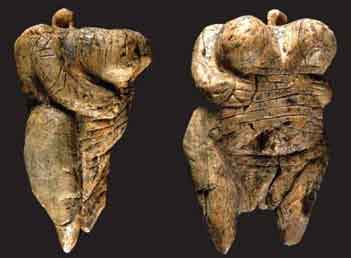
Additionally, the Woman of Willendorf is a particularly famous example of this type of figure. While initially thought to be symbols of fertility, or of a fertility goddess, the true significance of the figure remains obscure, as does much of prehistoric art.

Prehistory is divided roughly into three sections:
Paleolithic – Old Stone Age 2.5 million years ago to end of last Ice Age c. 9600 BCE
Mesolithic – Middle Stone Age – end of last ice age, agriculture, domestication of animals including the dog
Neolithic – New Stone Age – farming spreads to Western Europe, large-scale stone structures like Stonehenge in England
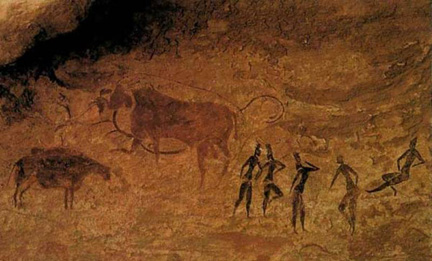
Further South in present-day Algeria, the Sahara desert was a vast savanna grassland suitable for the husbanding of herds of animals. This rock painting seems to picture a group of women watching the herd and entertaining themselves by – possibly – dancing. The artist has used the natural coloring of the rock outcropping to create a platform on which one of the figures reclines. This image confirms the activity of animal husbandry as well as advanced cultural and communal exchanges among the people who lived there.
Mesolithic Age
The period between the Paleolithic Age and the Neolithic Age is known as the Meso (Middle) Lith (Stone) ic period. The years attributed to this period vary from region to region, but it roughly corresponds to the time in Northern Europe during which the climate began to warm and the glaciers to recede.
Some characteristics of the Mesolithic Age is a transition from large chipped stone tools and hunting in groups of large herd animals to smaller (microliths) chipped stone tools and a more hunter-gatherer culture. It ends with the introduction of the growing of crops and husbanding of animals in the Neolithic.
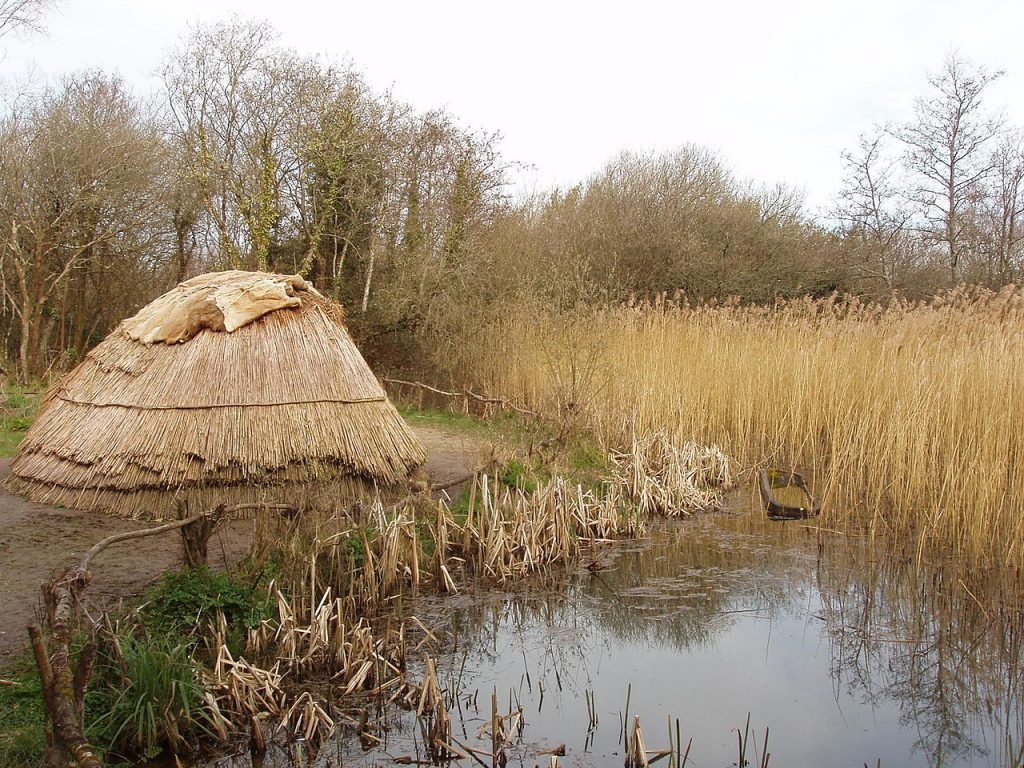
There is rather less art attributed to the Mesolithic than in the period prior and subsequent. Certain regions developed a distinctive pottery during this period. Possibly the most significant and long-lasting development during the Mesolithic is the domestication of the dog.
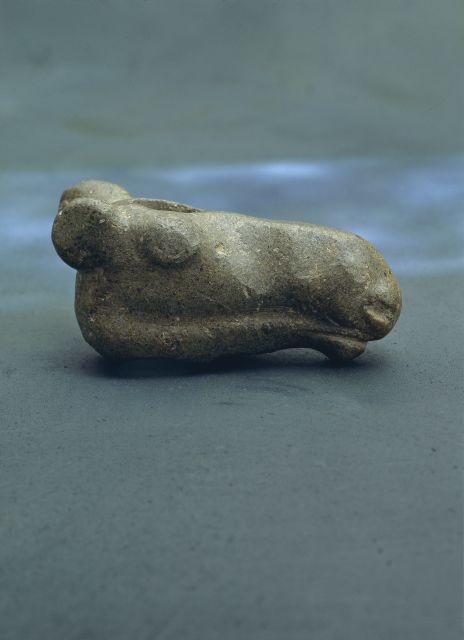
Neolithic Monuments
Neolithic art in Western Europe is best represented by its megalithic (large stone) monuments.
Key Points
- The Neolithic or New Stone Age was a period in human development from around 10,000 BCE until 3,000 BCE.
- Stonehenge and Avebury, both located in the county of Wiltshire in England, are the best known megalithic henges (circles). Both were built in stages over several centuries. Their exact purposes remain a matter of debate.
- Passage tombs or graves consist of narrow passages made of large stones and one or multiple burial chambers been covered in earth or stone. A common layout is the cruciform passage grave.
- The carvings at Newgrange and Knowth are aligned with the solstices and equinoxes.
Key Terms
- rectilinear: In a straight line.
- henge: A prehistoric enclosure in the form of an arc, defined by a raised circular bank and a circular ditch inside the bank, with one or more entrances to the enclosed open space.
- trilithon: A structure consisting of two stone pillars supporting a horizontal stone.
- cruciform: Having the shape of a cross.
- serpentiform: Having the form of a serpent.
- curvilinear: Formed by curved lines.
- passage grave: A burial chamber consisting of a narrow passage made of large stones and one or multiple burial chambers covered in earth or stone.
Also known as the New Stone Age, the Neolithic period in human development lasted from around 10,000 BCE until 3,000 BCE. Considered the last part of the Stone Age, the Neolithic is signified by a progression in behavioral and cultural characteristics including the cultivation of wild and domestic crops and the use of domesticated animals.
Agrarian societies first appeared in southeast Europe in the seventh millennium BCE. Through migration and cultural diffusion, Neolithic traditions spread to northwestern Europe by around 4500 BCE. The development of agriculture allowed groups of people to form larger permanent settlements in single locations, as opposed to living as nomadic hunter gatherers. Permanent settlements resulted in the construction of megalithic monuments requiring considerable time and effort that was unavailable to nomads.
Megalithic Henges
Neolithic societies produced female and animal statues, engravings, and elaborate pottery decoration. In Western Europe, though, this period is best represented by the megalithic (large stone) monuments and passage tomb structures found from Malta to Portugal, through France and Germany, and across southern England to most of Wales and Ireland.
Stonehenge
Perhaps the best known megalithic henge is Stonehenge, located on Salisbury Plain in the county of Wiltshire in south-central England. Archaeologists believe it was constructed from 3000 BCE to 2000 BCE. The surrounding circular earth bank and ditch, which constitute the earliest phase of the monument, have been dated to about 3100 BCE. Radiocarbon dating suggests that the first bluestones in the innermost ring of Stonehenge were raised between 2400 and 2200 BCE, although they may have been at the site as early as 3000 BCE.

Although human remains have been found at the site, archaeologists are uncertain whether the site served funerary purposes, ritual purposes, or both. Its alignments with the sunrise of the summer solstice and sunset of the winter solstice present the possibility that the site served as a rudimentary astronomical calendar to help early agrarian societies acclimate to the approaching growing season and harvest.

Even the smallest bluestones weigh several tons each. These stones, so-called because they appear blue when wet, were quarried approximately 150 miles away in the Prescelli Mountains in southwest Wales. Even more impressive, the quarrying and transport of the stones took place without the aid of the wheel, requiring a sophisticated method of transport and construction involving felled trees and earthen mounds. The larger Sarcen stones that form the post-and-lintel ring and he free-standing trilithons were quarried approximately 25 miles to the north of Salisbury Plain, requiring the same transport system of felled trees and earthen mounds.

